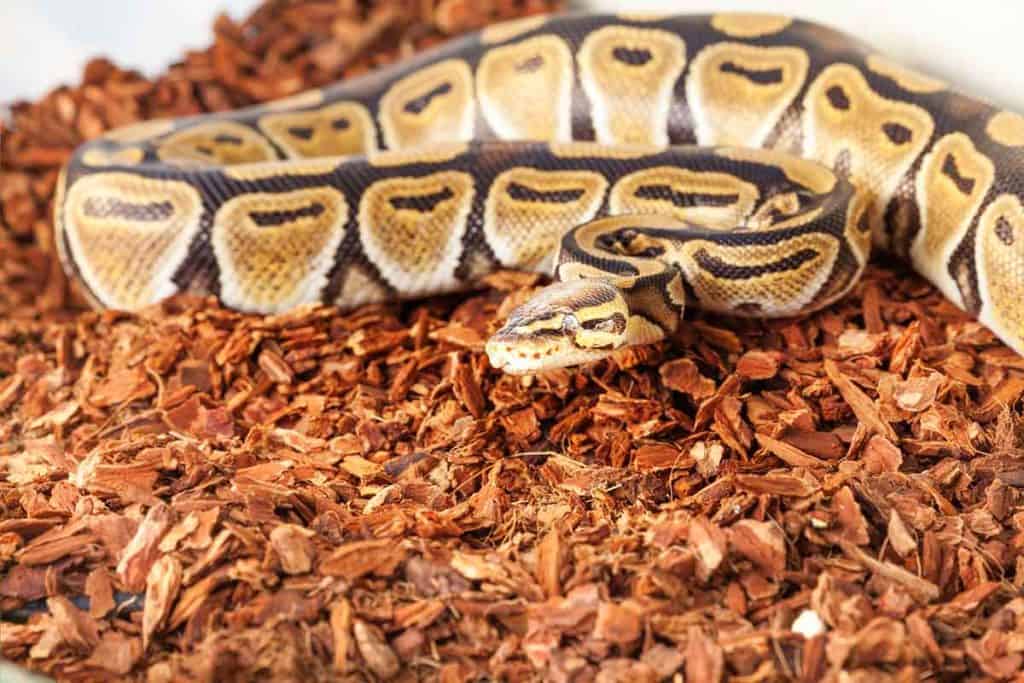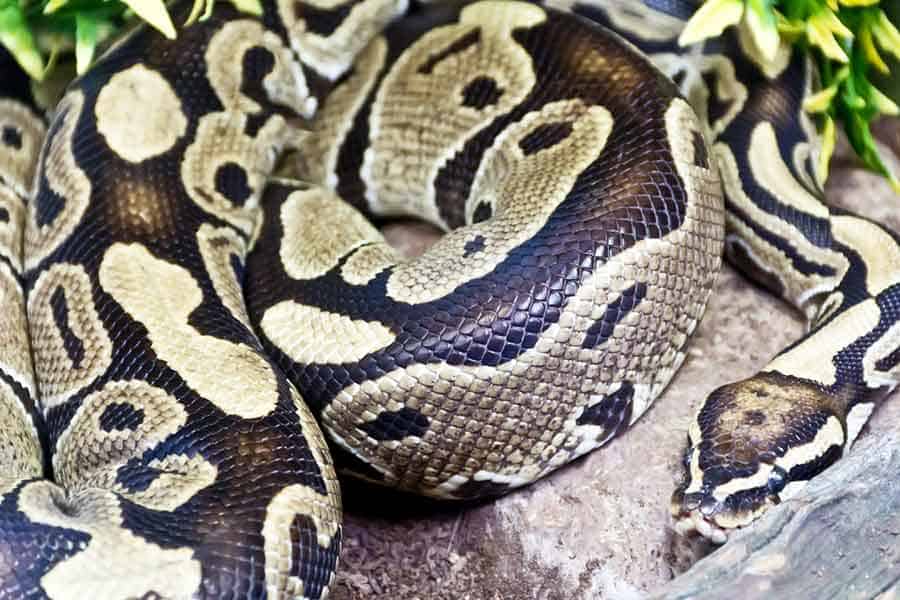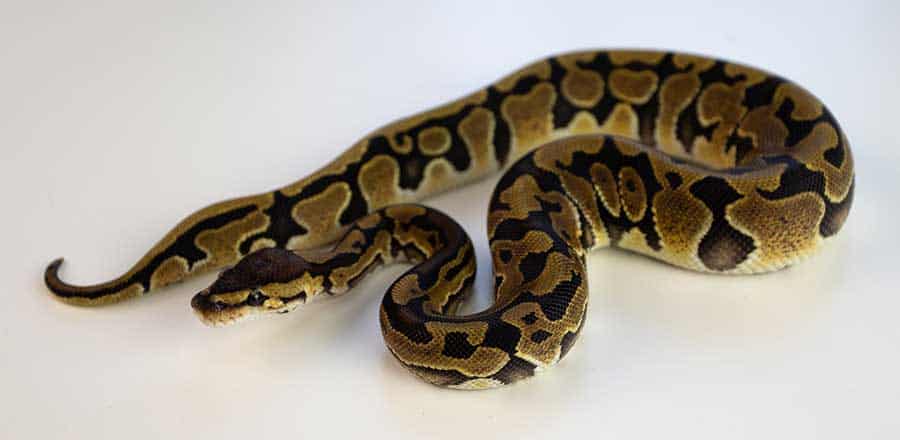Ball pythons are one of the most popular snakes in the pet industry. They have simple care needs and live a long lifespan, which makes them great pets for first-time snake owners. If you are a newbie yourself, you may be wondering: how big do ball pythons get?
Knowing how big your full grown ball python will eventually be is important because you need to plan for their care for the entirety of their 30-to-40-year lifespan!
Ball python females can get up to six feet in length and weigh six pounds! Male ball pythons, on the other hand, are considerably smaller than females and measure at around three feet and two pounds once fully grown.
Additionally, obesity is the leading cause of death in captive ball pythons, so it is also important to track your snake’s growth rate. Keeping a record of their weight and length along with their age will help you pinpoint if something is going wrong with their development.
Read on to find out about the factors that can affect your ball python’s growth!
Ball Python Size and Growth Chart by Age
Below is a table that lists the recommended enclosure sizes for differently sized snakes..
Keep in mind these are the minimum enclosure size suggestions. However, bigger is always better, provided you have included enough logs, rocks, foliage, and hides in the enclosure to provide cover and make your ball python feel comfortable and secure.
The height is not a huge factor for ball python enclosures because they are terrestrial snakes and therefore do not need much vertical space for climbing. Prioritize horizontal space rather than vertical space when choosing an enclosure for your snake.
The table also details the average growth rates for male and female ball pythons.
These averages should be a guideline that your very own ball python will follow. On average, male ball pythons will grow 8 inches and females will grow 12 to 16 inches every year until they are fully grown.
Factors That Affect Ball Python Growth
Your ball python’s maximum size will be determined by its genetics. There is nothing you can do to increase that size. However, there are three main factors that can affect whether or not your snake reaches their maximum possible size and how quickly they grow..
Enclosure Size and Exercise
If your ball python is housed in an enclosure that is too small for it to feel comfortable, then it will not be able to grow to its maximum size.
Cramped, small enclosures stunt the size of ball pythons because there is not enough floor space for them to move around and get the exercise needed for their bones and muscles to develop properly.
Diet and Obesity
As I mentioned earlier, obesity is the leading cause of death in ball pythons.
Ball pythons can be very finicky eaters and may refuse food for a very long time, either initially or due to stress, illness, or injury. However, when they do decide to eat, they will easily eat as many prey items as you are willing to feed them.
Babies and juveniles should be fed once every seven days, while sub-adults and adults should be fed once every 14 days. Keeping to a feeding schedule will help your snake build a stable relationship with food and discourage it from refusing meals.
Ball pythons and snakes in general can go a very long time, often weeks or even months, without a meal.
Overfeeding them when they do start taking food is a common beginner mistake. Unfortunately, this leads to obesity and encourages unhealthy eating habits. Be sure to avoid overfeeding your snake when they do end up taking food from you to keep them at a healthy weight.
Illness and Parasites
If your ball python is ill or has a parasite infestation, then it will have a stunted growth rate if it is left untreated. Many illnesses or infestations can also cause diarrhea, which means your snake will become dehydrated and unable to process its food properly.
In turn, the lack of hydration and nutrition will prevent it from reaching its full growth. Keep a close eye on your snake’s behavior and take them to a veterinarian as soon as possible if they show signs of illness or parasites.
FAQs About Ball Python Growth
How do I track my ball python’s growth?
Print out the size and growth rate chart in this article and keep it in a book or on your phone! As your ball python grows up, measure it and weigh it every so often. Note these values down in the book to keep a careful track record.
This record will help you track your scaly baby’s growth as well as provide an indicator if something is going wrong.
When you bring your snake in for its check-up at the vet, bring this record with you so the vet can take a look and tell you how your ball python is doing!
How do I measure my ball python?
The older your ball python gets, the more hands you are going to need to help you measure them if they are a bit feisty or very active.
Lay your snake flat on a surface, or in a kind helper’s hands, and hold a tape measure at its nose. Then work your way down its body and measure at its vent (cloaca) and record the number. Then continue the measurement from its nose to the tip of its tail and record that number, too.
It is important to have both of these numbers recorded because they represent the total body length without the tail and the total body length with the tail.
How do I safely weigh my ball python?
The easiest way to weigh your ball python is to gently put it in a cloth bag it can breathe in. Once your snake is in the bag, you can measure it on a standing scale, a kitchen scale, or a hook/hanging scale used for fishing or luggage weighing.
You can also place a container on the scale, zero it, and then place your snake in it to weigh it.
Always weigh your snake after its last poop but before you feed it its next meal to get an accurate measurement of its body weight.
How often should I weigh and measure my ball python?
Weigh your ball python at least once a month to keep track of its growth. Once your ball python has reached the four-year mark, weigh it once every six months to keep an eye on its health.
Measure your ball python once a month for the first three to four years of its life. Once it hits the three-to-four-year mark, it will be a fully-grown ball python!
Can I power feed my ball python to increase its size?
Power feeding snakes is a way to make them grow as fast as possible. It is not healthy to power feed snakes, however, because it puts strain on their organs.
Power feeding your ball python might make it reach its full size earlier than it would have naturally, but you will also likely shorten its lifespan considerably.
Balling Up…
How big do ball pythons get? Pretty big, as it turns out! However, they are very manageable and make excellent pets thanks to their calm temperaments. Fully-grown female ball pythons can reach six feet and weigh six pounds, but males are much smaller!
With proper care and a regular feeding schedule, you can help your ball python reach its maximum length and live a long, healthy life.




